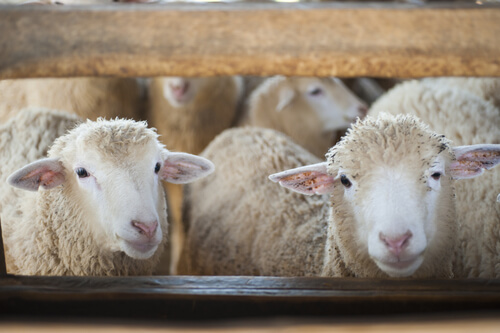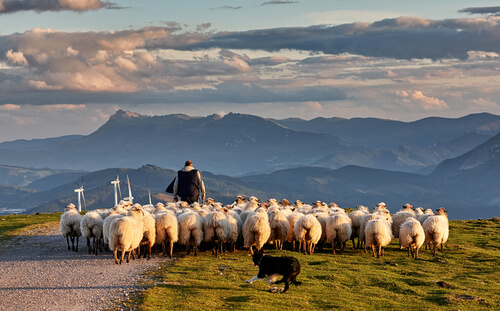The Feeding and Temperament of Sheep
Sheep are a species with a gentle temperament and prolonged feeding. Discover the characteristics of an animal that provides us with so much!

There are many animals that can be kept as pets, and dogs, hamsters, cats, and birds aren’t the only ones. For those who live in the countryside, a group of sheep, goats, or cows can be an excellent choice. Apart from the companionship of the animals, keeping these herbivores also provides raw materials, such as wool and milk. Although keeping a sheep as a pet is full of benefits, you should also bear in mind that their requirements aren’t the same as those of most domestic animals. Here, we’ll tell you all about the diet and temperament of sheep, as well as some of its socialization needs.
The general characteristics of the sheep
The domestic sheep (Ovis orientalis aries) is a quadruped and ungulate mammal. The latter means that it belongs to the clade Ungulata, which also includes zebras, rhinoceroses, giraffes, elks, and many other herbivorous animals. All these animals support themselves and walk with the end of their toes, which are covered by a hoof.
The sheep is an animal that has been domesticated for more than 7,000 years by man, and its primary ancestor is believed to be the eastern mouflon (Ovis orientalis). A well domesticated and fed sheep can provide wool, milk, meat, and fat to a community. For this reason, sheep have been highly valued by humankind because of their usefulness.
The habitat of sheep is quite varied and highly dependent on the breed, as up to 10,000 different varieties have been recorded within this subspecies. Areas that sheep may inhabit include grassland plains, semi-desert areas, cold areas near polar regions, and not so polar areas, but at high altitude.
In general, the most widespread characteristic of sheep habitat is its temperate to cold temperature. This allows the wool to develop with more quality and thickness. However, a sheep will be happy in almost any climate as long as it’s close to its flock. Remember that they’re warm-blooded animals (endotherms), so their distribution isn’t overly dependent on environmental temperature.
The countries with the most sheep are Australia, China, India, Iran, and Nigeria, although they live almost everywhere in the world. The average sheep lives for 10 to 12 years. However, in optimal health, with a proper diet, sufficient exercise, and a stress-free environment, a sheep can live more than 20 years.
The general temperament of sheep
Sheep are shy animals with a gentle temperament. They prefer quiet, peaceful places to graze and ruminate, as they may associate noise with the presence of predators. In general, sheep are social animals. This means that they prefer to stay with the group and will rarely wander off alone.
Sheep are very intelligent animals. Studies have confirmed that a sheep can recognize up to 50 individual members of its own species, 5 dogs, and at least 10 humans. Of course, like companion animals, sheep learn their names if given one and come when called.
Due to their social nature, sheep excel at herding behavior. This means that if one of them moves dramatically, the rest will follow (although it’s not an entirely good idea). The young always follow the older ones, so there’s a certain pecking order in their societies.
Sheep require the company of other sheep of the same species. As professional sources indicate, a minimum of 5 of them is required for them to be able to develop their flock behavior. Interestingly, a sheep will reduce its stress index during any activity (eating and moving, among others) if it maintains eye contact with another sheep.
Sheep are prey animals in their natural environment. Therefore, they require constant companionship so that they don’t get stressed and don’t feel unprotected.

Morphological characteristics and reproduction
In general, sheep measure some 4 feet, 4 inches in length and 1 and a half to 3 feet, 3 inches in height depending on their breed. Specimens of smaller sheep breeds may weigh 77 pounds, while larger sheep will weigh over 220 kilograms.
Sheep hair is commonly known as wool and its market value depends on the quality of the hair and the breed. The coat of sheep is generally light in color, although some variants have dark hairs that are highly desirable in the textile market. The suffolk breed is a perfect example, as it always has a black head and legs.
Although sight isn’t the strong point of these animals, they have an excellent sense of hearing and smell. Because they’re able to move their pinnae (ears), they can pinpoint the exact source of any sound.
Although their auditory and olfactory senses are quite acute, and they perceive elements at a long distance, the sheep’s vision is quite limited (their depth perception isn’t very good). In addition, due to the location of their eyes, the angle of view is rather poor. This can vary from 191° to 306°, depending on the amount of wool on their head.
Ewes have several estrus periods in a year. Once a ewe has been fertilized, gestation lasts about 150 days (approximately 5 months). Usually, like humans, sheep have only one offspring per gestation.
Feeding a sheep
Sheep are ruminants. This means that a sheep’s stomach is divided into four parts. When a sheep eats food, it goes into the first stomach. Soon after, the sheep regurgitates the food, chews it again, and it goes into the second stomach. This process is repeated four times. In this way, they get as many nutrients as possible from a low-nutrient raw material (such as grass).

For this reason, sheep usually feed early in the morning and in the late afternoon only. Sheep spend the rest of the time ruminating on the ingested food.
Sheep are herbivorous animals. In a natural state, where sheep can graze freely, they’ll feed on grasses, shrubs, and legumes. In general, these animals are considered primarily grazers and consume grass in large quantities.
The diet of a sheep will vary slightly according to breed. Small breeds tend to eat more fiber than large breeds, although large breeds tend to eat more diverse plant foods. Either way, a sheep can consume an enormous amount of food in a short time. It does this in order to digest what it eats slowly and parsimoniously.
A sheep will consume 2 to 3% of its body weight in grass each day. Therefore, a 220 pound sheep will consume 4.5 to 2 to 6.5 pounds of grass in 24 hours. They also require specific feed in proportion to 0.5-1.5% of their body weight.
Eating habits determine the character and temperament of a sheep. In general, sheep are peaceful and calm animals that avoid shocks and adventures. They’re very sociable and friendly animals when they’ve been treated properly by their keepers.

